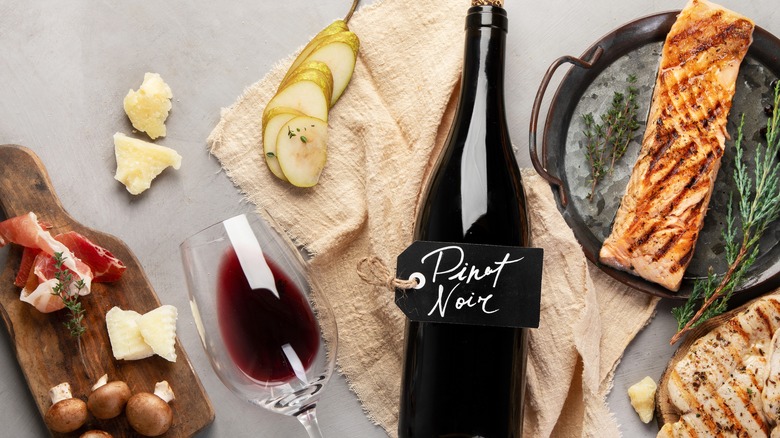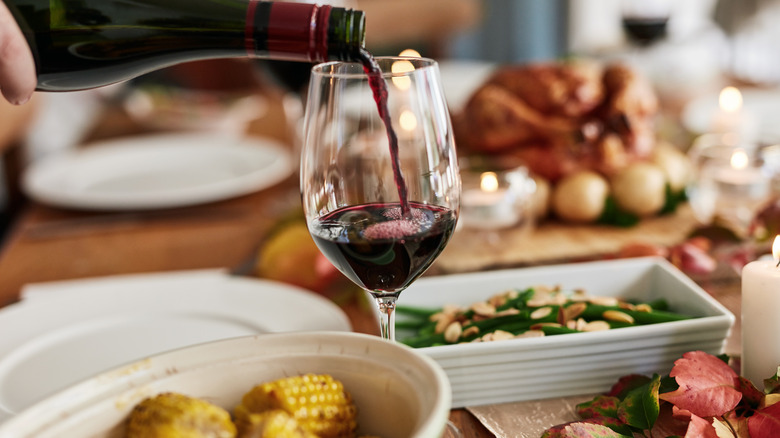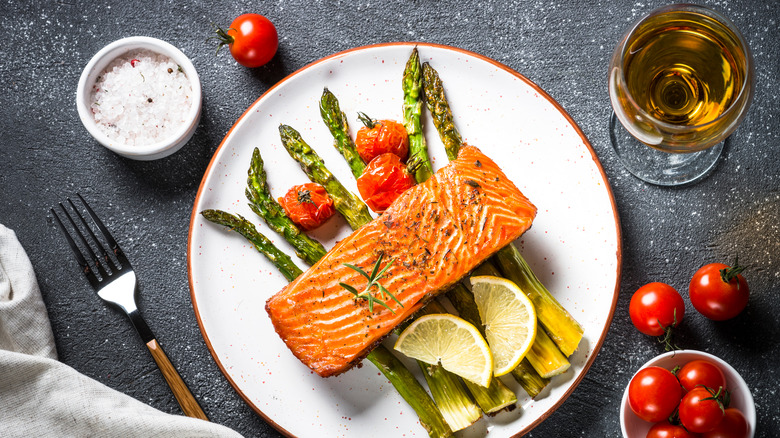One Mistake To Resist When Pairing Wine With Salmon
Salmon is a super versatile fish. It can be prepared with anything from a light lemon garlic sauce to a spicy honey glaze. Just as it takes on an array of flavors in cooking, it can just as well be paired with an array of wines, including reds. Yes, even reds.
A lot of people know white wine pairs well with fish, and that tends to be true. The higher acidity in white wines like sauvignon blanc and riesling is refreshing with fish. Since salmon is a heartier fish with more fat than light flaky fish like halibut, it can stand up against heartier wines including rosé, skin contact white, and some reds. When opting for a red, the trick is to keep it light and bright.
For example, pinot noir, gamay, and grenache can be delicious paired with salmon. The one mistake you want to avoid making is pairing tannic heavy red wines with salmon, as tannins can end up overpowering the delicate flavor of the fish — no matter how it's prepared.
Avoid heavy reds
Tannins in wine are what make your tongue feel scrubby after drinking it. They are primarily extracted from the skin of the grape during fermentation, adding body, texture, and flavor to the wine. In pairings, salt in foods helps soften tannins, so drinking tannic wines with naturally salty foods is ideal. That is why a heavy cabernet sauvignon, which has lots of tannins, is paired with a salty steak, or a syrah with well-seasoned grilled duck.
Fish is delicate and does not require the same amount of salt seasoning as other heavier proteins, which is why you don't want to pair most fish dishes with heavily tannic red wines. Additionally, you want to pair wine with similar power and flavor as the food. A heavy red can overpower a delicate salmon dish. However, a high-acid, light red can let the fish shine.
Take, for example, a pomegranate-glazed salmon, which would be brilliant paired with a Lambrusco, a zesty and sparkling red wine from Italy. The wine will offer ample acidity and highlight the dish's pomegranate notes, without overpowering the salmon.
Experiment with pairings
Wine learning also involves unlearning. Try pairings that might not work. If an opportunity presents itself, try a salmon dish with a heavy tannin red wine. Notice how the fish coats your palate with light oils. Then, take a sip of the heavy red wine. Observe how the abrasive tannins make your palate scrubby and completely overtake the flavors, to the point where you don't taste the fish at all. It may even give your palate a metallic taste.
Next, repeat the experiment with a light-bodied red with lighter tannins, such as a pinot noir from Burgundy. The floral and red fruit notes of the wine will complement the flavor of the salmon, and the light tannins won't interfere with the flavors. Most importantly, the acidity in the wine will cut through the fattiness of the fish, making the whole experience refreshing.
Which wine pairs well with the fish will also be determined by the preparation and sauce. A baked salmon with light flavors will go with a lighter wine. A grilled salmon with smokier flavors will go with a plummier, heavier wine, just not a heavily tannic one. It's all a spectrum.
At the end of the day, it's also about what you like. Everyone's palates are different, and no preference is wrong. Learning your preference is the key part, and that comes with practice and experimentation. Don't be afraid to try different combinations and learn, or unlearn, as you go. Cheers!


